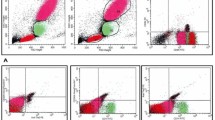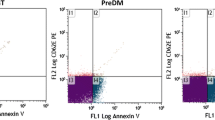Abstract
Introduction
Type two diabetes mellitus (T2DM) remains a leading contributor to cardiovascular mortality worldwide. This study was conducted to investigate the pattern of circulating EMPs in T2DM patients in comparison with MetS subjects.
Methods
The study retrospectively included 101 patients (54 subjects with T2DM and 47 patients with MetS) and 35 healthy volunteers. All the patients gave written informed consent for participation in the study. Biomarkers were measured at baseline of the study.
Results
There is a significant difference between healthy subjects and patients regarding CD31+/annexin V+ EMPs to CD62E+ EMPs ratio, which reflects impaired phenotype of EMPs. Therefore, CD31+/annexin V+ EMPs to CD62E+ EMPs ratio was found to be higher in the T2DM patients compared to MetS patients. Using multivariate linear regression analyses, independent impact of T2DM (r = 0.40, P = 0.003), OPG (r = 0.37, P = 0.001), hs-CRP (r = 0.347, P = 0.001), and adiponectin (r = 0.33, P = 0.001) on increased CD31+/annexin V+ to CD62E+ ratio of EMPs was determined. Using C-statistics, we found that inflammatory biomarkers (hs-C-reactive protein, osteoprotegerin and adiponectin) added to the base model (T2DM) improved the relative IDI by 12.6 % for increased CD31+/annexin V+ EMPs to CD62E+ EMPs ratio.
Conclusion
We found that patients with T2DM and MetS may be distinguished by predominantly appearing phenotypes of circulating EMPs associated with pro-inflammatory cytokine overproduction. Elevated CD31+/annexin V+ EMPs to CD62E+ EMPs ratio is an indicator of impaired immune phenotype of EMPs, which allows determining the pattern of EMPs in dysmetabolic disorder patients.


Similar content being viewed by others
References
Nichols GA, Schroeder EB, Karter AJ, Gregg EW, Desai J, Lawrence JM, O’Connor PJ, Xu S, Newton KM, Raebel MA, Pathak RD, Waitzfelder B, Segal J, Lafata JE, Butler MG, Kirchner HL, Thomas A, Steiner JF, SUPREME-DM Study Group (2015) Trends in diabetes incidence among 7 million insured adults, 2006–2011: the SUPREME-DM project. Am J Epidemiol 181(1):32–39
Szczerbińska K, Topinková E, Brzyski P, van der Roest HG, Richter T, Finne-Soveri H, Denkinger MD, Gindin J, Onder G, Bernabei R (2014) The characteristics of diabetic residents in European nursing homes: results from the SHELTER study. J Am Med Dir Assoc. doi:10.1016/j.jamda.2014.11.009 (epub ahead of print)
Eliasson B, Gudbjörnsdottir S (2014) Diabetes care—improvement through measurement. Diabetes Res Clin Pract 106(2):S291–S294
Eschwege E, Basdevant A, Crine A, Moisan C, Charles M (2014) Type 2 diabetes mellitus in France in 2012: results from the ObEpi survey. Diabetes Metab. doi:10.1016/j.diabet.2014.11.007 (epub ahead of print)
Pickup JC (2004) Inflammation and activated innate immunity in the pathogenesis of type 2 diabetes. Diabetes Care 27:813–823
Huber CA, Diem P, Schwenkglenks M, Rapold R, Reich O (2014) Estimating the prevalence of comorbid conditions and their effect on health care costs in patients with diabetes mellitus in Switzerland. Diabetes Metab Syndr Obes 7:455–465
McMurray SD (2014) The fight against diabetes: how the kidney care community is taking action. Nephrol News Issues 28(10):30–32
Moreno PR, Fuster V (2004) New aspects in the pathogenesis of diabetic atherothrombosis. J Am Coll Cardiol 44(12):2293–2300
Wong ND, Patao C, Malik S, Iloeje U (2014) Preventable coronary heart disease events from control of cardiovascular risk factors in US adults with diabetes (projections from utilizing the UKPDS risk engine). Am J Cardiol 113(8):1356–1361
van Sloten TT, Henry RM, Dekker JM, Nijpels G, Unger T, Schram MT, Stehouwer CD (2014) Endothelial dysfunction plays a key role in increasing cardiovascular risk in type 2 diabetes: the Hoorn study. Hypertension 64(6):1299–1305
Jia G, Sowers JR (2014) Endothelial dysfunction potentially interacts with impaired glucose metabolism to increase cardiovascular risk. Hypertension 64(6):1192–1193
Zaghloul A, Al-Bukhari TA, Al-Pakistani HA, Shalaby M, Halawani SH, Bajuaifer N, Teama SH (2014) Soluble endothelial protein C receptor and high sensitivity C reactive protein levels as markers of endothelial dysfunction in patients with type 1 and type 2 diabetes mellitus: their role in the prediction of vascular complications. Diabetes Res Clin Pract 106(3):597–604
Markiewicz M, Richard E, Marks N, Ludwicka-Bradley A (2013) Impact of endothelial microparticles on coagulation, inflammation, and angiogenesis in age-related vascular diseases. J Aging Res 2013:734509
Barteneva NS, Fasler-Kan E, Bernimoulin M, Stern JN, Ponomarev ED, Duckett L, Vorobjev IA (2013) Circulating microparticles: square the circle. BMC Cell Biol 14:23
Guay C, Regazzi R (2015) Role of islet microRNAs in diabetes: which model for which question? Diabetologia 58(3):456–463
Wu ZH, Ji CL, Li H, Qiu GX, Gao CJ, Weng XS (2013) Membrane microparticles and diseases. Eur Rev Med Pharmacol Sci 17(18):2420–2427
Tetta C, Bruno S, Fonsato V, Deregibus MC, Camussi G (2011) The role of microvesicles in tissue repair. Organogenesis 7(2):105–115
Martinez MC, Andriantsitohaina R (2011) Microparticles in angiogenesis: therapeutic potential. Circ Res 109:110–119
Rautou PE, Vion AC, Amabile N, Chironi G, Simon A, Tedgui A, Boulanger CM (2011) Microparticles, vascular function, and atherothrombosis. Circ Res 109(5):593–606
Kurtzman N, Zhang L, French B, Jonas R, Bantly A, Rogers WT, Moore JS, Rickels MR, Mohler ER 3rd (2013) Personalized cytomic assessment of vascular health: evaluation of the vascular health profile in diabetes mellitus. Cytometry B Clin Cytom 84(4):255–266
(2013) Executive summary: standards of medical care in diabetes—2013. Diabetes Care 36(1):S4–S10
National Cholesterol Education Program (NCEP) Expert Panel on Detection, Evaluation, and Treatment of High Blood Cholesterol in Adults (Adult Treatment Panel III) (2002) Third report of the national cholesterol education program (NCEP) expert panel on detection, evaluation, and treatment of high blood cholesterol in adults (adult treatment panel III) final report. Circulation 106(25):3143–3421
Bluemke DA, Achenbach S, Budoff M, Gerber TC, Gersh B, Hillis LD, Hundley WG, Manning WJ, Printz BF, Stuber M, Woodard PK (2008) Noninvasive coronary artery imaging: magnetic resonance angiography and multidetector computed tomography angiography: a scientific statement from the American heart association committee on cardiovascular imaging and intervention of the council on cardiovascular radiology and intervention, and the councils on clinical cardiology and cardiovascular disease in the young. Circulation 118:586–606
Levey AS, Stevens LA, Schmid CH, Zhang YL, Castro AF 3rd, Feldman HI, Kusek JW, Eggers P, Van Lente F, Greene T, Coresh J, for the CKD-EPI (Chronic Kidney Disease Epidemiology Collaboration) (2009) A new equation to estimate glomerular filtration rate. Ann Intern Med 150(9):604–612
Matthews DR, Hosker JP, Rudenski AS, Naylor BA, Treacher DF, Turner RC (1985) Homeostasis model assessment: insulin resistance and beta-cell function from fasting plasma glucose and insulin concentrations in man. Diabetologia 28:412–419
Tam CS, Xie W, Johnson WD, Cefalu WT, Redman LM, Ravussin E (2012) Defining insulin resistance from hyperinsulinemic-euglycemic clamps. Diabetes Care 35(7):1605–1610
Berezin AE, Kremzer AA (2014) Relationship between circulating endothelial progenitor cells and insulin resistance in none-diabetic patients with ischemic chronic heart failure. Diabetes Metab Syndr Clin Res Rev 8:138–140
Friedewald WT, Levy RI, Fredrickson DS (1972) Estimation of the concentration of low-density lipoprotein cholesterol in plasma, without use of the preparative ultracentrifuge. Clin Chem 18(6):499–502
Orozco AF, Lewis DE (2010) Flow cytometric analysis of circulating microparticles in plasma. Cytometry A 77(6):502–514
Lacroix R, Judicone C, Mooberry M, Boucekine M, Key NS, Dignat-George F (2013) The ISTH SSC workshop. standardization of pre-analytical variables in plasma microparticle determination: results of the international society on thrombosis and haemostasis SSC collaborative workshop. J Thromb Haemost. doi:10.1111/jth.12207 (epub ahead of print)
Leroyer AS, Tedgui A, Boulanger CM (2008) Microparticles and type 2 diabetes. Diabetes Metab 34(1):S27–S32
Amabile N, Cheng S, Renard JM, Larson MG, Ghorbani A, McCabe E, Griffin G, Guerin C, Ho JE, Shaw SY, Cohen KS, Vasan RS, Tedgui A, Boulanger CM, Wang TJ (2014) Association of circulating endothelial microparticles with cardiometabolic risk factors in the Framingham heart study. Eur Heart J 35(42):2972–2979
Nomura S (2009) Dynamic role of microparticles in type 2 diabetes mellitus. Curr Diabetes Rev 5(4):245–251
Puddu P, Puddu GM, Cravero E, Muscari S, Muscari A (2010) The involvement of circulating microparticles in inflammation, coagulation and cardiovascular diseases. Can J Cardiol 26(4):140–145
Jimenez JJ, Jy W, Mauro LM, Soderland C, Horstman LL, Ahn YS (2003) Endothelial cells release phenotypically and quantitatively distinct microparticles in activation and apoptosis. Thromb Res 109(4):175–180
Arteaga RB, Chirinos JA, Soriano AO, Jy W, Horstman L, Jimenez JJ, Mendez A, Ferreira A, de Marchena E, Ahn YS (2006) Endothelial microparticles and platelet and leukocyte activation in patients with the metabolic syndrome. Am J Cardiology 98(1):70–74
Eaton S (2006) Release and trafficking of lipid-linked morphogens. Curr Opin Genet Dev 16:17–22
Chironi GN, Boulanger CM, Simon A, Dignat-George F, Freyssinet JM, Tedgui A (2009) Endothelial microparticles in diseases. Cell Tissue Res 335(1):143–151
Shantsila E (2009) Endothelial microparticles: a universal marker of vascular health? J Hum Hypertens 23:359–361
Camussi G, Deregibus MC, Bruno S, Grange C, Fonsato V, Tetta C (2011) Exosome/microvesiclemediated epigenetic reprogramming of cells. Am J Cancer Res 1:98–110
Théry C, Ostrowski M, Segura E (2009) Membrane vesicles as conveyors of immune responses. Nat Rev Immunol 9:581–593
Poulsen MK, Nybo M, Dahl J, Hosbond S, Poulsen TS, Johansen A, Høilund-Carlsen PF, Beck-Nielsen H, Rasmussen LM, Henriksen JE (2011) Plasma osteoprotegerin is related to carotid and peripheral arterial disease, but not to myocardial ischemia in type 2 diabetes mellitus. Cardiovasc Diabetol 10:76–84
Müller G, Schneider M, Biemer-Daub G, Wied S (2011) Microvesicles released from rat adipocytes and harboring glycosylphosphatidylinositol-anchored proteins transfer RNA stimulating lipid synthesis. Cell Signal 23(7):1207–1223
Wang Y, Chen LM, Liu ML (2014) Microvesicles and diabetic complications—novel mediators, potential biomarkers and therapeutic targets. Acta Pharmacol Sin 35(4):433–443
Jansen F, Yang X, Hoelscher M, Cattelan A, Schmitz T, Proebsting S, Wenzel D, Vosen S, Franklin BS, Fleischmann BK, Nickenig G, Werner N (2013) Endothelial microparticle-mediated transfer of MicroRNA-126 promotes vascular endothelial cell repair via SPRED1 and is abrogated in glucose-damaged endothelial microparticles. Circulation 128(18):2026–2038
Sinning JM, Losch J, Walenta K, Böhm M, Nickenig G, Werner N (2011) Circulating CD31+/Annexin V+ microparticles correlate with cardiovascular outcomes. Eur Heart J 32(16):2034–2041
Mause SF, Weber C (2010) Microparticles: protagonists of a novel communication network for intercellular information exchange. Circ Res 107(9):1047–1057
Montoro-García S, Shantsila E, Marín F, Blann A, Lip GY (2011) Circulating microparticles: new insights into the biochemical basis of microparticle release and activity. Basic Res Cardiol 106(6):911–923
Berezin AE (2014) Circulating endothelial-derived apoptotic microparticles as novel perspective biomarker for diabetes. Diabetes Res Treat Open Access 1(4):117–120. doi:10.14437/DRTOA-1-117
Berezin AE, Kremzer AA, Martovitskaya YV, Samura TA, Berezina TA (2015) The predictive role of circulating microparticles in patients with chronic heart failure. BBA Clin 3:18–24
Berezin AE, Kremzer AA, Martovitskaya YV, Samura TA, Berezina TA (2014) The biomarker risk prediction score in chronic heart failure. J Dis Mark 1(1):8
Acknowledgments
We thank all the patients for their participation in the investigation, staff of the Regional Zaporozhye Hospital (Ukraine), and the doctors, nurses, and administrative staff of the Regional Center of Cardiovascular Diseases (Zaporozhye, Ukraine) and City Hospital #6 (Zaporozhye, Ukraine), general practices, and site-managed organizations that assisted with the study.
Conflict of interest
The authors declare no conflicts of interest.
Ethical approval
All procedures performed in studies involving human participants were in accordance with the ethical standards of State Medical University, Zaporozhye, Ukraine and with the 1964 Helsinki declaration and its later amendments or comparable ethical standards.
Informed consent
Informed consent was obtained from all individual participants included in the study.
Author information
Authors and Affiliations
Corresponding author
Rights and permissions
About this article
Cite this article
Berezin, A.E., Kremzer, A.A., Samura, T.A. et al. Impaired immune phenotype of circulating endothelial-derived microparticles in patients with metabolic syndrome and diabetes mellitus. J Endocrinol Invest 38, 865–874 (2015). https://doi.org/10.1007/s40618-015-0273-z
Received:
Accepted:
Published:
Issue Date:
DOI: https://doi.org/10.1007/s40618-015-0273-z




